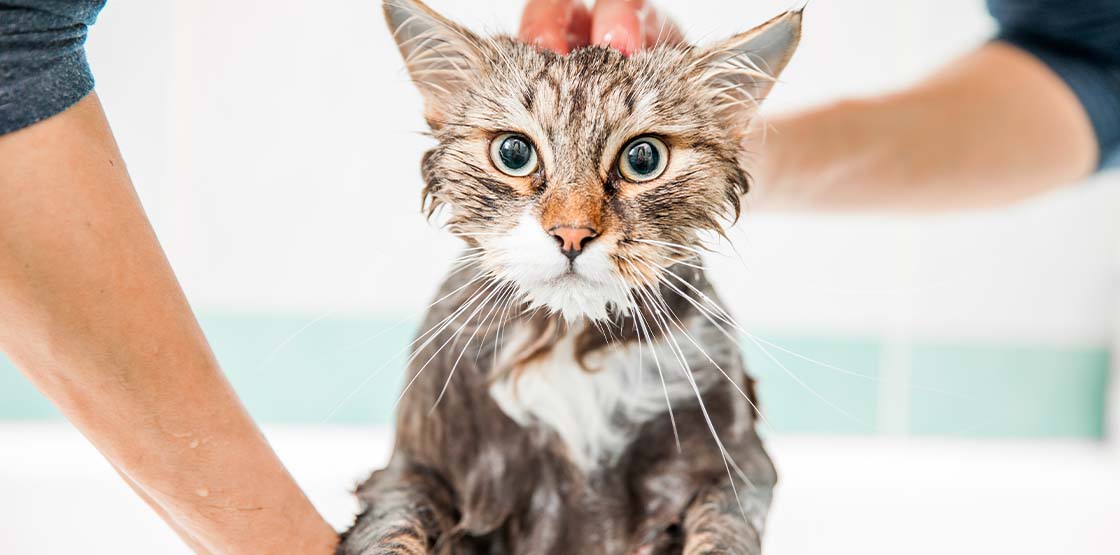How to Bathe a Cat
When you own a cat, you may not consider what steps to take for grooming them, especially because your frisky feline is often quite capable of bathing themselves. Despite this, there are times when you need to give your cat a bath and being prepared is half the battle. With a little bit of patience, the whole process does not even have to be a battle and you can get your kitty clean quickly and efficiently. We’ll offer you some tips for how to bathe a cat.
Reasons to Bathe Your Cat
While many cats bathe themselves, there are some times when they need a little helping hand. Maybe they got startled in the carrier and urinated, soaking through their coat. Overweight kitties also have a lot more trouble grooming themselves compared to cats at an ideal weight, so they are more likely to get greasy spots and mats in their hair coat.
In some cases, your cat might have a skin infection caused by bacteria or fungi like ringworm, in which case a medical bath could be needed. For cats with significant flea infestations, a quick flea bath can rinse some of the fleas off before you apply a flea prevention.
What Do You Need to Bathe Your Cat?
The most important thing you need when bathing your cat is the appropriate shampoo. You want a shampoo specifically designed for cats, as it will be gentle enough to avoid drying out their coat and has a pH balanced to minimize any disruptions to their skin. Please note that human shampoo is not designed for cats; the pH of our bodies is different than that of our cats. In some cases, your cat may also need a conditioner, particularly if they have long hair that might get easily tangled or if they have dry skin.
When you bathe your cat, you also need some towels to dry them off. Some cats do not mind being dried with a hair dryer, but most prefer the quiet method of towel drying. You will also need a small cloth to wipe off their face.
In addition to an area to bathe your cat, you might need a pitcher or plastic cup to pour water over their body to get them wet and rinse them off. Another consideration for you is to use rubber gloves. These will help protect you from scratches if your cat is resistant to being bathed.
Where to Bathe Your Cat
Many people find that bathing their cat in the kitchen sink or a utility sink is a great way to spare their back. Bathing here can minimize the bending and leaning you might have to do when bathing your kitty.
Tubs or shower stalls can also be used to bathe your cat, but you will generally need to kneel and bend over to bathe them. If you decide to use your bathroom for bathing your cat, make sure you have a non-slip mat in the tub to help them maintain their footing.
You May Also Like:
Related Search Topics (Ads):
How to Bathe Your Cat
Step 1
Before you begin bathing your cat, brush them to get rid of any loose hair or dander and untangle any mats.
Step 2
For bathing, start by filling your sink or tub with a couple inches of water. The water should be lukewarm rather than overly warm. If the water is too warm, when your cat gets out of the water and dried off, their skin may dry out more readily. In addition, you do not want to burn your cat with water that is too hot.
Step 3
Carefully wet your cat from the neck down their body. Make sure not to get water in their eyes or ears. As such, it is best to just avoid their face entirely and clean that last.
Step 4
Apply the shampoo to your cat's coat, working up a good lather and massaging their skin. If the shampoo needs to set on your cat's fur for a few minutes, you might consider taking them out of the water and setting them on a fluffy towel.
Step 5
Rinse your cat's fur well. Use the spray nozzle gently or carefully pour water with a pitcher or cup until your cat is rinsed and no evidence of shampoo remains.
Step 6
If you are conditioning your cat, apply the conditioner per the manufacturer's (or your veterinarian's) instructions. Follow the previous steps and rinse the fur well.
Step 7
Now it is time to clean off your cat's face. Unless you need to use medicated shampoo on their face, just use a clean and damp washcloth to wipe off their face.
Step 8
Once your cat is cleaned off, lift them out of the water and onto a nice, dry towel. Gently rub as much of the water out of their fur as possible. If your cat tolerates a hair dryer, you can blow dry them on low heat, but keep in mind that this stresses many cats out and extra stress should be avoided, as they are probably not happy having had a bath.
Step 9
Throughout this entire process, you want to avoid getting water and shampoo or conditioner into your cat's eyes, ears, or nose. After you have bathed them, consider taking a cotton ball or gauze square and gently wiping out their ears. You can use a general ear cleaner after the bath to clean their ears if they are dirty, but you want to make sure to clean out any water that got into their ears.
Step 10
After you have dried your cat, it is time to brush out any tangles, particularly if they have long hair. Do so gently. Consider a wide-toothed comb.
In Summary
Bathing your cat can be an important part of their grooming routine, particularly if they have coat conditions. As with anything with your kitty, move slowly while they get used to it and give them plenty of praise and affection.

